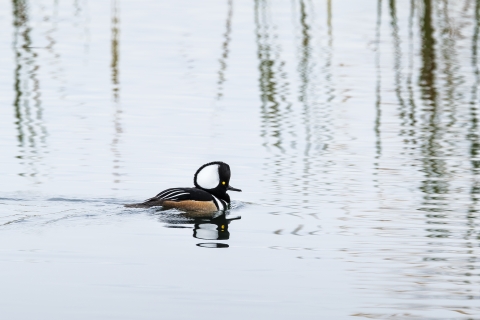Visit Us
Other than during hunting seasons, Cold Springs NWR is all about peace and quiet. It's a great place to have a quiet picnic, walk the access roads (and forthcoming trails) with binoculars in search of birds, or just sit in the shade and wait for wildlife to come to you. Even the fishing is quiet—we only allow electric boat motors.
Wildlife observation and photography are encouraged. In fact, they're almost mandatory. With all bird life, especially waterfowl, at Cold Springs, we don't see how you could avoid at least breaking out your cell phone camera to snap a photo or two. Hiking is allowed in all areas open to the public. Please stay out of closed areas to minimize disturbance to plants and animals. Bicycling is allowed only on designated public access routes; it is not allowed on trails or roads closed to public vehicles or horses. Horseback riding is allowed on signed refuge public access routes open to motor vehicles.
Fishing from the bank is allowed year round in areas of the refuge open to public access (see map). Crappie and bass are the favored targets. As boats are not allowed on the reservoir from October 1 through the end of February, fishing from a boat or floatation device during that period is prohibited. From March 1 through September 30, only non-motorized boats and boats with electric motors are permitted; gasoline or other internal combustion engines are prohibited. All other regulations and seasons follow state of Oregon regulations.
Sport hunting for ducks, geese, dove, coot, snipe, and upland gamebirds is permitted on the refuge in accordance with all state and federal regulations. Elk is only open to emergency hunting administered by the Oregon Department of Fish & Wildlife.
Cold Springs is open year-round during daylight hours; a half-hour before dawn to a half hour after sunset.
Location and Contact Information
About Us
Cold Springs National Wildlife Refuge was one of the first refuges established in the West, created by President Theodore Roosevelt on February 25, 1909. Cold Springs NWR was established primarily to benefit waterfowl and other native birds. However, the 3,102-acre refuge, while small, provides a surprising variety of habitats and abundance of many other wildlife species. The open water on the reservoir attracts large numbers of Canada geese and ducks. Dense riparian riparian
Definition of riparian habitat or riparian areas.
Learn more about riparian areas provide cover for migrating and nesting songbirds. Shrub-steppe areas support coyotes, badgers, ring-necked pheasants, several hawk species and trophy elk and deer, along with dozens of other mammal, reptile and amphibian species.
Overlying a Bureau of Reclamation water storage reservoir, Cold Springs NWR is a blend of open water, managed wetland, riparian, grassland and shrub-steppe habitats. The reservoir itself is notable in that it has three water sources—directly from Cold Springs Creek, from a gravity-fed canal system draining from the Umatilla River and from water pumped through a canal system from the Columbia River, although the latter is used infrequently and only in low-water years in the Umatilla River. What this means to wildlife and recreational users is that the water supply is very consistent and assured.
Located in north-central Oregon approximately two miles southeast of Hermiston, Oregon, Cold Springs NWR is one of the unknown gems of the National Wildlife Refuge System. Although no surveys have been done to determine the exact number of refuge users, or the activities engaged in, anecdotally the FWS knows that use is low and is focused around hunting and fishing, with birdwatching, horseback riding and day-use (e.g., picnicking, social gathering) accounting for additional visitor use days. Most use appears to be from nearby residents, and the refuge is not known to be a ‘destination’ area for visitors from outside the immediate area.
What We Do
The staff and volunteers at Cold Springs National Wildlife Refuge work to maintain and enhance refuge lands and to provide programs for both wildlife and the community. Our conservation toolbox includes controlling invasive species invasive species
An invasive species is any plant or animal that has spread or been introduced into a new area where they are, or could, cause harm to the environment, economy, or human, animal, or plant health. Their unwelcome presence can destroy ecosystems and cost millions of dollars.
Learn more about invasive species , restoring degraded habitat, creating new habitat, and seasonally or permanently closing some lands to provide sanctuary areas for wildlife.
Our Species
The wide variety of habitats (open water, mudflat, native grassland, seasonal wetland, riparian riparian
Definition of riparian habitat or riparian areas.
Learn more about riparian and shrub-steppe) in such a small provides for a diverse assemblage of species. The refuge is home to 212 documented species of birds, at least 21 species of mammals, 14 presumed species of reptiles and amphibians, and at least 7 species of fish.

